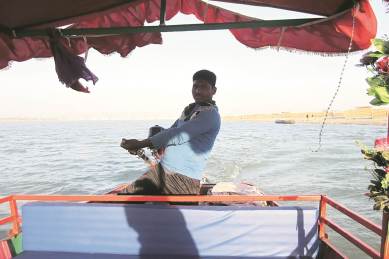UP Polls 2017: More to Ayodhya than temple politics; residents call for tourism push
Ayodhya is a prestige constituency for the BJP. It rose to power on the back of the Ram Mandir movement and, after the demolition, won the assembly seat four times before suffering a shock defeat to the SP in 2012.

Near the entrance of the disputed site where the Babri Masjid was demolished on December 6, 1991, a TV set plays out a documentary on the demolition and police action and compares the firing on kar sevaks to General Dyer’s action at Jallianwalla Bagh.
WATCH VIDEO | Assembly Elections 2017: How Has UP Voted In The Past Explained
monthly limit of free stories.
with an Express account.
Sunil Kumar, a Khatik Dalit, sells CDs and books on the demolition and history of Ayodhya. He says Mulayam Singh Yadav got kar sevaks killed and he is still angry about it. He says he will vote for the BJP. His reason: “After demonetisation the price of arhar dal fell to Rs 60 a kilo, and I could afford it. It was a great move by Narendra Modi.”
A kilometre away at Naya Ghat on the banks of the Sarayu, Sanjay Manjhi, 23, and Guddu Manjhi, 27, are sitting idle on their motorboats. They say hardly any people come to boat and there are very few opportunities for work. They would like a government that would bring about some improvement in tourism.
“There is so much more in Ayodhya than just the Babri Masjid and Ram temple. Have you ever heard of that? No. Why will people come here?” says Guddu.
People here say they stopped talking about the temple long ago, although BJP leaders have once again raked it up. “No one cares about the temple in Ayodhya,” says Durga Prasad Maurya, a taxi driver who claims to have witnessed the demolition as a teenager. “We are tired of hearing that promise. People want work opportunities, development. Look at Ayodhya. It’s the birthplace of Ram. This place should have been the biggest pilgrimage site in the country. But more people go to Haridwar because it has been developed and promoted.”
Though a lot of people come to visit the disputed site, locals say they are not tourists ready to spend money. “This place needs to be beautified, given good hotels. Only then will people come here and stay. So much politics has happened over Ayodhya, but people have got nothing,” says Maurya, who makes Rs 300 to Rs 500 a day and will vote for the BJP as he has always done.
Guddu Manjhi has been running his boat for the past four years. He finds tourists who come to Ayodhya are unwilling to spend. “We charge just Rs 20 per passenger. But no one is ready to pay that either. Fifteen people will sit in and then pay just Rs 100. You can’t protest; someone else will be ready to take them for that price,” he says, adding that there are 40 boats on the ghat and none of them makes more than Rs 300 a day.
Ayodhya is a prestige constituency for the BJP. It rose to power on the back of the Ram Mandir movement and, after the demolition, won the assembly seat four times before suffering a shock defeat to the SP in 2012.
Maurya says a transgender candidate contesting independently played an important role in 2012. “Gulshan Bindu, the candidate, took up some important issues concerning the public and was seen by the electorate as very sincere. BJP MLA Lallu Singh on the other hand was smug with his consistent success. Bindu ended up getting a significant number of votes, helping the SP’s Pawan Pandey win,” says Maurya.
The Ram ki Paidi in Ayodhya serves as an example of temple politics overshadowing the concerns of the people of the temple town. What might have stood in competition to the Har ki Paidi, Haridwar, instead lies with garbage floating around.
“Vinay Katiyar, who made his political career out of the temple issue, was chosen from here twice. He did nothing for the region,” says Maurya.
Ram Prasad Sonkar, a Khatik paanwalla near the disputed site, says the temples in the town have become big business. “You cannot imagine the amount of money that comes into temples in Ayodhya.. If they spend just 10 per cent of what they get on the development of Ayodhya’s tourist sites, it will transform the lives of people here,” Sonkar says.
Locals say most temples are headed by mahants who came from Bihar after the demolition and took control. “There is a gunfight every year for control of temples,” claims Rajan Pandey, 22, who runs a souvenir shop near Kanak Bhavan.
Sonkar claims that during demonetisation, several businessmen came with sacks full of currency to exchange in Ayodhya temples, only to find the temples themselves struggling with their stash.
The fight this year is seen as between the BJP and the SP. “Yadavs and Muslims are voting for the SP. But the candidate is seen here as having made a lot of money in his tenure. That may go against him,” says Parshuram Yadav of Tyora Majha village in Kallu Purwa area of Ayodhya.